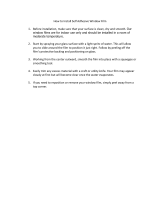15
Important Information – Read Carefully
Safety
If smoke or a fire occurs in the oven, press
Stop/Cancel button and leave the door closed
in order to stifle any flames.
Disconnect the power cord, or shut off power
at the fuse or the circuit breaker panel.
Short Cooking Times
As microwave cooking times are much shorter
than other cooking methods it is essential that
recommended cooking times are not exceeded
without first checking the food.
Cooking times given in the cookbook are
approximate. Factors that may affect cooking
times are: preferred degree of cooking, starting
temperature, altitude, volume, size and shape
of foods and utensils used. As you become
familiar with the oven, you will be able to
adjust these factors.
It is better to undercook rather than overcook
foods. If food is undercooked, it can always be
returned to the oven for further cooking. If food
is overcooked, nothing can be done. Always
start with minimum cooking times.
Important
If the recommended cooking times are
exceeded the food will be spoiled and in
extreme circumstances could catch fire and
possibly damage the interior of the oven.
1.
Small Quantities of Food
Take care when heating small quantities of
food as these can easily burn, dry out or
catch fire if cooked too long. Always set
short cooking times and check the food
frequently.
NEVER OPERATE THE OVEN WITHOUT
FOOD INSIDE ON MICROWAVE OR
COMBINATION MODE INVOLVING
MICROWAVE
2.
Foods low in moisture
Take care when heating foods low in
moisture, e.g. bread items, chocolate,
biscuits and pastries. These can easily
burn, dry out or catch on fire if cooked too
long. We do not recommend heating foods
low in moisture such as popcorn or
poppodums. The microwave oven is
intended for heating food and beverages
only. Drying of food, newspapers or
clothing and heating of warming pads,
slippers, sponges, damp cloth, wheat
bags, hot water bottles and similar may
lead to risk of injury, ignition or fire.
3.
Christmas Pudding
Christmas puddings and other foods high
in fats or sugar, e.g. jam, mince pies, must
not be over heated. These foods must
never be left unattended as with over
cooking these foods can ignite. See page
70.
4.
Boiled Eggs
Do not cook eggs in their shells and whole
hard-boiled eggs by MICROWAVE.
Pressure may build up and the eggs may
explode, even after the microwave heating
has ended.
5.
Foods with Skins
Potatoes, apples, egg yolk, whole
vegetables and sausages are examples of
food with non porous skins. These must be
pierced using a fork before cooking to
prevent bursting.
6.
Liquids
Liquids and other foods must not be
heated in sealed containers since they are
liable to explode. When heating liquids, eg
soup, sauces and beverages in your
microwave oven, overheating the liquid
beyond boiling point can occur without
evidence of bubbling.
This could result in a sudden boil over of
the hot liquid. To prevent this possibility
the following steps should be taken:
a. Avoid using straight-sided containers
with narrow necks.
b. Do not overheat.
c. Stir the liquid before placing the
container in the oven and again halfway
through the heating time.
d. After heating, allow to stand in the oven
for a short time, stirring again before
carefully removing the container.
e. Microwave heating of beverages can
result in delayed eruptive boiling,
therefore care should be taken when
handling the container.




















